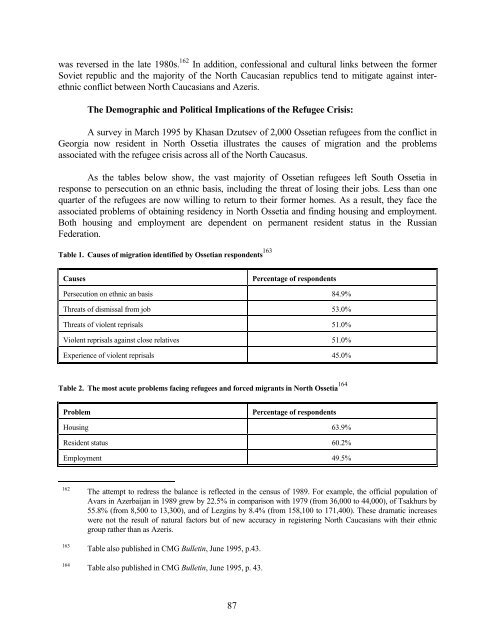RUSSIA'S TINDERBOX - Belfer Center for Science and International ...
RUSSIA'S TINDERBOX - Belfer Center for Science and International ...
RUSSIA'S TINDERBOX - Belfer Center for Science and International ...
Create successful ePaper yourself
Turn your PDF publications into a flip-book with our unique Google optimized e-Paper software.
was reversed in the late 1980s. 162 In addition, confessional <strong>and</strong> cultural links between the <strong>for</strong>mer<br />
Soviet republic <strong>and</strong> the majority of the North Caucasian republics tend to mitigate against interethnic<br />
conflict between North Caucasians <strong>and</strong> Azeris.<br />
The Demographic <strong>and</strong> Political Implications of the Refugee Crisis:<br />
A survey in March 1995 by Khasan Dzutsev of 2,000 Ossetian refugees from the conflict in<br />
Georgia now resident in North Ossetia illustrates the causes of migration <strong>and</strong> the problems<br />
associated with the refugee crisis across all of the North Caucasus.<br />
As the tables below show, the vast majority of Ossetian refugees left South Ossetia in<br />
response to persecution on an ethnic basis, including the threat of losing their jobs. Less than one<br />
quarter of the refugees are now willing to return to their <strong>for</strong>mer homes. As a result, they face the<br />
associated problems of obtaining residency in North Ossetia <strong>and</strong> finding housing <strong>and</strong> employment.<br />
Both housing <strong>and</strong> employment are dependent on permanent resident status in the Russian<br />
Federation.<br />
Table 1. Causes of migration identified by Ossetian respondents 163<br />
Causes Percentage of respondents<br />
Persecution on ethnic an basis 84.9%<br />
Threats of dismissal from job 53.0%<br />
Threats of violent reprisals 51.0%<br />
Violent reprisals against close relatives 51.0%<br />
Experience of violent reprisals 45.0%<br />
Table 2. The most acute problems facing refugees <strong>and</strong> <strong>for</strong>ced migrants in North Ossetia 164<br />
Problem Percentage of respondents<br />
Housing 63.9%<br />
Resident status 60.2%<br />
Employment 49.5%<br />
162 The attempt to redress the balance is reflected in the census of 1989. For example, the official population of<br />
Avars in Azerbaijan in 1989 grew by 22.5% in comparison with 1979 (from 36,000 to 44,000), of Tsakhurs by<br />
55.8% (from 8,500 to 13,300), <strong>and</strong> of Lezgins by 8.4% (from 158,100 to 171,400). These dramatic increases<br />
were not the result of natural factors but of new accuracy in registering North Caucasians with their ethnic<br />
group rather than as Azeris.<br />
163 Table also published in CMG Bulletin, June 1995, p.43.<br />
164 Table also published in CMG Bulletin, June 1995, p. 43.<br />
87
















